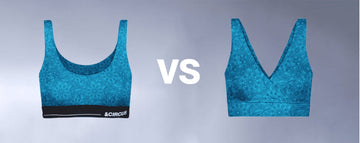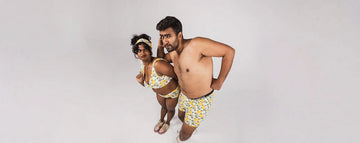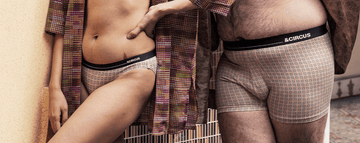You're swiping through Instagram when a quick clip stops you cold: a bead of water hits a piece of fabric, rolls off like it's allergic to sticking around, and disappears. The text overlay reads, “Why your underwear needs to wick moisture.” It's not just a clever trick it's a window into a quiet revolution in intimate apparel. Brands are using short-form videos to unpack the science of cooling fabrics, showing eco-conscious consumers why their next pair of underwear should do more than just look good. In an era where comfort and sustainability are non-negotiable, these videos are rewriting the rules of what we expect from our most personal garments.
Moisture-wicking fabrics, engineered to draw sweat away from the skin and keep you dry, have been a staple in athletic wear for years. But their migration into everyday underwear signals a broader shift. The global market for these fabrics, valued at $1.84 billion in 2024, is expected to climb to $4.16 billion by 2034, growing at an 8.5% compound annual rate. North America leads with a 35% market share, while Asia Pacific is poised for rapid growth at a 9.1% annual rate. This isn't just about numbers it's about a new breed of consumer who demands performance, comfort, and ethics in equal measure. Videos, from TikTok snippets to YouTube Shorts, are proving to be the perfect tool to bring this story to life.
Why video? Because today's shoppers don't trust buzzwords like “breathable” or “sustainable” without proof. They want to see the fabric in action how it handles sweat, how it feels after a long day. Brands are stepping up, using visual storytelling to make complex fabric technology accessible and compelling.
Uncomfortable underwear shouldn't steal your confidence. At Andcircus, we craft ultra-soft, sustainable Lenzing Modal Micro® innerwear for every body, XS to 5XL. From briefs to bras, our custom packs fit you perfectly. Shop risk-free with our 100% satisfaction guarantee and embrace comfort that includes everyone. #LoveEveryBody. Shop Now!
The Surge of Smart Fabrics in Everyday Wear
The underwear industry is undergoing a high-tech transformation. Fabrics like micromodal and bamboo blends are taking center stage, offering a soft, luxurious feel while pulling moisture away from the body. Unlike cotton, which traps sweat and clings uncomfortably, these materials are built for performance, even in the most intimate contexts. The moisture-wicking fabrics market is expanding rapidly, driven by growing demand for activewear, outdoor gear, and now, everyday essentials like underwear. Rising fitness trends, increased outdoor activities, and advancements in eco-friendly materials are pushing this growth, with applications spilling into fashion, healthcare, and even automotive sectors.
What's behind this shift? A generational pivot. Younger consumers Millennials and Gen Z aren't just buying clothes; they're curating lifestyles. They want underwear that performs during a morning run, a packed workday, or a humid evening out, all while aligning with their environmental values. Synthetic fibers hold a commanding 72% of the market in 2024, prized for their durability and wicking power. Yet natural fibers, like bamboo, are catching up, expected to grow at an 8.05% annual rate through 2034 as sustainability becomes a dealbreaker for shoppers.
Short-form videos are tailor-made for this moment. A 30-second clip can show a fabric repelling water or staying dry during a workout, turning abstract claims into concrete evidence. Brands are capitalizing on this, using platforms like Instagram and TikTok to connect with consumers who value authenticity and instant results.
Brands Making Science Visual
Consider a video where an influencer pours water onto two fabric swatches one cotton, one moisture-wicking bamboo. The cotton absorbs the water, looking heavy and drenched. The bamboo? The water beads up and slides off, leaving the fabric pristine. It's a simple, powerful visual that communicates performance in seconds. Sustainable underwear brands are leaning into these demonstrations to make fabric science relatable.
Take a fictional brand, “PurePulse Threads.” They've teamed up with fitness creators to produce Reels comparing their micromodal boxer briefs to traditional cotton during a sweaty gym session. The cotton wearer fidgets, visibly uncomfortable. The PurePulse wearer moves with ease, dry and confident. These videos don't just sell they educate, showing why fabric choice matters for comfort and performance.
Other brands are pulling back the curtain with behind-the-scenes content. Some film lab tests, zooming in on water droplet experiments that highlight how their fabrics repel moisture through capillary action. Others use time-lapse videos to show sweat evaporating faster on wicking fabrics than on cotton. These glimpses into the engineering process build trust, offering consumers a transparent look at what makes their underwear exceptional.
Comparison videos are another hit. One brand might stage a test under a heat lamp, pitting their moisture-wicking briefs against cotton ones. The cotton turns damp and clingy; the wicking fabric stays dry. It's a straightforward way to prove a point, and it resonates with consumers who want evidence, not just promises.
The Hurdles of Selling Fabric Tech
It's not all easy wins. Consumers are skeptical, burned by too many “revolutionary” claims that don't hold up. Brands need to deliver visual proof, but translating microscopic fabric functions like sweat being wicked through tiny channels into engaging video content is no small feat. It's hard to make a fiber's inner workings cinematic.
Then there's the challenge of balancing education with entertainment. Videos need to be concise ideally under a minute to keep viewers hooked, but they also need to convey enough substance to convince doubters. Lean too technical, and you lose the audience. Go too flashy, and you risk looking like a shallow ad. Brands are navigating this tightrope, striving to make science both accessible and exciting.
The Business Case: Trust and Loyalty
Why invest in these videos? Because they deliver. Clear, visual explanations of how moisture-wicking fabrics work can reduce returns by aligning customer expectations with reality. If a shopper knows their underwear will keep them dry during a hectic day, they're less likely to send it back. Transparency fosters credibility, and credibility drives loyalty.
In a saturated market, where every brand claims to be “sustainable,” performance sets the winners apart. The moisture-wicking fabrics market is growing beyond sportswear into fashion and healthcare, and brands that communicate their value clearly gain a competitive edge. Videos that showcase both performance and ethics say, a bamboo brief that's both wicking and eco-friendly position brands as leaders in a crowded field.
The Future of Fabric Storytelling
The future of underwear is high-performance, sustainable, and increasingly visual. As augmented reality (AR) and virtual reality (VR) technologies evolve, imagine virtual try-ons that let you see how moisture-wicking briefs perform in a simulated workout or a sweltering commute. Or picture AI-driven videos that simulate sweat evaporating in real time, making fabric performance crystal clear. These innovations are coming, promising to make fabric education even more immersive.
For now, brands can amplify impact by pairing videos with practical content like care tips to maintain wicking performance or customer reviews that echo the science with real-world experiences. It's about building a dialogue, not just a transaction. As the cooling fabrics market heads toward $4.16 billion by 2034, one truth stands out: consumers don't just want comfort they want to understand it. And in a world of fleeting attention spans, a sharp, honest video might be the most persuasive teacher of all.
Frequently Asked Questions
Are there eco-friendly options for moisture-wicking innerwear?
Yes, many sustainable brands now offer innerwear made from biodegradable or recycled fibers that also feature moisture-wicking technology. These materials combine performance with environmental responsibility, making them ideal for consumers seeking comfort and sustainability in one package.
What are moisture-wicking fabrics, and why are they important in innerwear?
Moisture-wicking fabrics are designed to pull sweat away from the skin and allow it to evaporate quickly, keeping the wearer dry and comfortable. In innerwear, this property is crucial for maintaining hygiene, reducing chafing, and enhancing comfort—especially in warm climates or during physical activity.
How do educational videos help consumers understand moisture-wicking technology in clothing?
Videos provide visual demonstrations of how moisture-wicking fabrics function compared to conventional materials. They highlight testing results, fabric structure, and real-world applications, empowering consumers to make informed choices when shopping for breathable and performance-enhancing underwear.
Disclaimer: The above helpful resources content contains personal opinions and experiences. The information provided is for general knowledge and does not constitute professional advice.
You may also be interested in: Shop Mauve Lightly Padded Plunge Bra for Women Online- &Circus
Uncomfortable underwear shouldn't steal your confidence. At Andcircus, we craft ultra-soft, sustainable Lenzing Modal Micro® innerwear for every body, XS to 5XL. From briefs to bras, our custom packs fit you perfectly. Shop risk-free with our 100% satisfaction guarantee and embrace comfort that includes everyone. #LoveEveryBody. Shop Now!







































